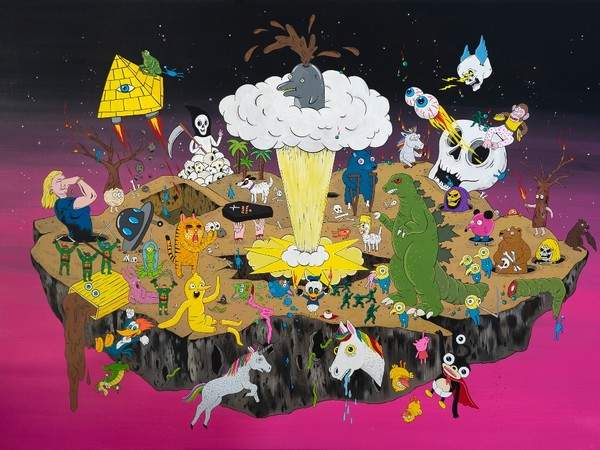The greats of the Italian Newbrow are on display in Pietrasanta with historic and previously unseen works
Unfolding in the spaces of the Complesso di Sant’Agostino in Pietrasanta is the new installment of the Italian Newbrow project, developed by Ivan Quaroni since his participation in the Prague Biennale in 2009, and curated, in this new stage promoted by the Municipality of Pietrasanta, by Quaroni himself and Valerio Dehò.
From June 20 to September 12, 2021, more than sixty works (works on canvas, paper and board, and video installations), many of them previously unpublished, by artists Silvia Argiolas, Vanni Cuoghi, Paolo De Biasi, Fulvia Mendini, Laurina Paperina, Giuliano Sale, and Giuseppe Veneziano, will be on display in the Church, Sala dei Putti, and Sala Capitolo.
Italian Newbrow presents and promotes a significant cross-section of that contemporary Italian painting that has been able to internalize the cultural and social changes of the liquid-modern society theorized by Zygmunt Bauman through the elaboration of heterogeneous languages, in which different pictorial attitudes coexist.
Newbrow is an Anglo-Saxon neologism that stands between the terms lowbrow and highbrow that stigmatize the opposition between a popular and a cultured art. Italian Newbrow is thus not a language or a school of thought, but rather an attitude, an inclination, and a mode of thinking that draws simultaneously on a plurality of iconographic sources, with references that include both allusions to popular culture (comics, illustration, cinema, and news) and references to high culture (art history, literature, architecture, and design).
Within the Newbrow cohort there are two souls: the pop, communicative and narrative wing, represented by the artists Laurina Paperina, Fulvia Mendini and Giuseppe Veneziano, who use linguistic codes close to comics, illustration and design to construct a commentary on contemporary global culture; the formalist wing, represented by Vanni Cuoghi, Paolo De Biasi, Giuliano Sale and Silvia Argiolas, more attentive to the definition of a language capable of combining technical experimentation and conceptual research. In both souls, the more or less veiled citation to the iconographies of art history constitutes a recurring element of that Italian (and European) iconographic heritage, which continues to surface in the visual codes of contemporaneity.
Each of the artists chosen for the Pietrasantese exhibition thus becomes an interpreter in his or her own way, and in very different ways, of this combination of high and low culture. What unfolds in the pictorial imagery of Silvia Argiolas, who on this occasion is presenting all unpublished paintings, is the story of a condition of social marginality and, at the same time, the examination of an experience that, against the falsity and virtuality of the digital world, elects the truth of the body and the psyche as the safeguard of the individual.
Vanni Cuoghi ’s works featured in the exhibition, canvases made between 2019 and 2021, show the evolution of his pictorial grammar from typically pop illustrative stylizations to the definition of a language suspended between beauty and horror, between classical and pop elements, that lends itself well to the transposition of contemporary anxieties into symbolic and fantastic keys.
Paolo De Biasi ’s neo-metaphysical interiors are organized like posing sets: a deconstructed space that interprets reality as a simultaneous jumbling of places and narrative episodes, which return to us the sense of urgency and vitality of human experience.
Fulvia Mendini ’s physiognomies (a dozen acrylics on panel can be admired in the exhibition) allude to the eternal feminine purged, however, of all dramatic connotations. Victorian fairies and nymphs are accompanied by Pre-Raphaelite Venuses and Secessionist ladies interpreted in the light of an ultra-flat grammar. The artist constructs a seemingly simple two-dimensional universe that conceals references to refined episodes of art history.
On display is a significant selection of canvases and video-animations by Laurina Paperina whose language draws on the vast repertoire of pop iconography, adapting it to a linear and synthetic style that allows the artist to treat the most gory themes with an attitude of cynical candor.
Giuliano Sale paints fragmented bodies and spaces that are a pure mental projection of his states of mind, in which shreds of the pictorial imagery of the great masters of the past are filtered through a pictorial style that alternates precision and gestures, construction and decomposition, ferocity and elegance condensed into an original and unique language.
At the crossroads of reality and fiction, fantasy and chronicle, the painting of Giuseppe Veneziano (on view with some of his most famous works, such as Self Portrait, Mc Emmaus and Michael Jackson’s Pieta, from 2010) is marked by a synthetic style and a color palette veering toward pastel tones: Narrative short-circuits that cause us to reconsider the ephemeral boundary between the real and the verisimilar, as when he retrieves an artistic iconography from the past and transforms it into a commentary on the vices and virtues of the contemporary world.
Accompanying the exhibition is a catalog published by NFC Edizioni, with critical texts by Valerio Dehò and Ivan Quaroni.
For all information you can call +39 0584 795500 or visit the official website of the Museum of Sketches.
Pictured: Laurina Paperina, Atomic Bomb (acrylic on canvas; 120 x 170 cm)
 |
| The greats of the Italian Newbrow are on display in Pietrasanta with historic and previously unseen works |
Warning: the translation into English of the original Italian article was created using automatic tools. We undertake to review all articles, but we do not guarantee the total absence of inaccuracies in the translation due to the program. You can find the original by clicking on the ITA button. If you find any mistake,please contact us.




























